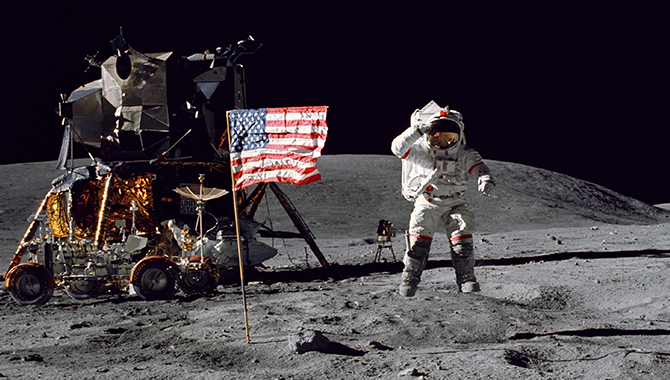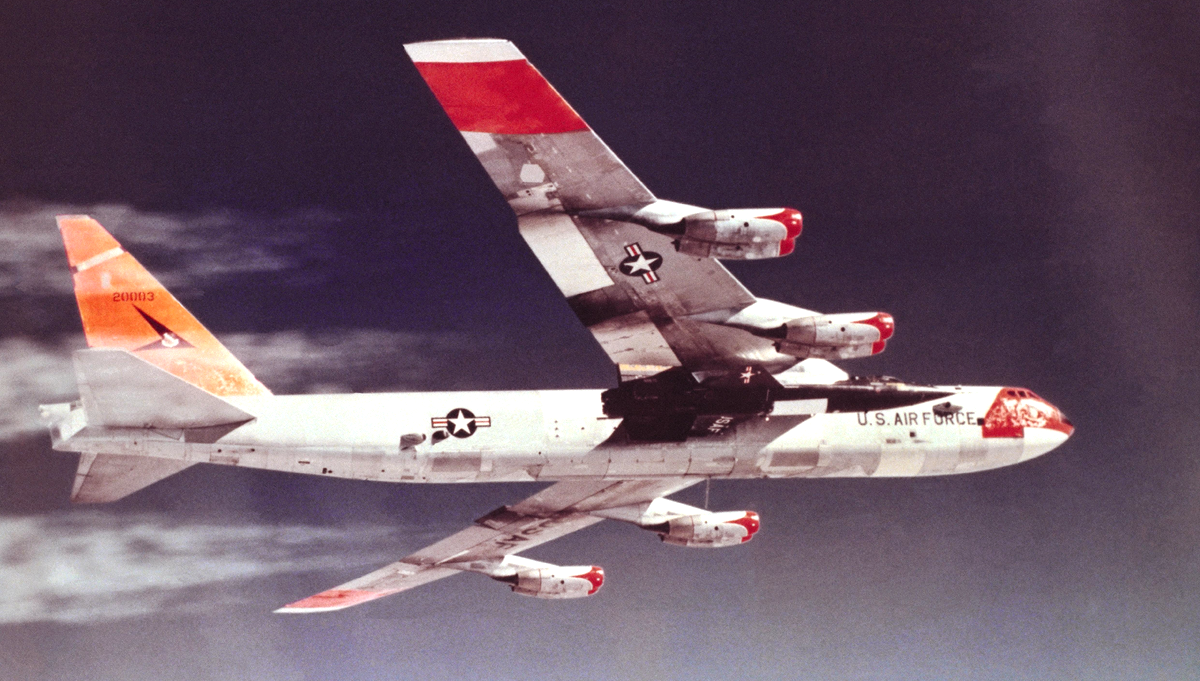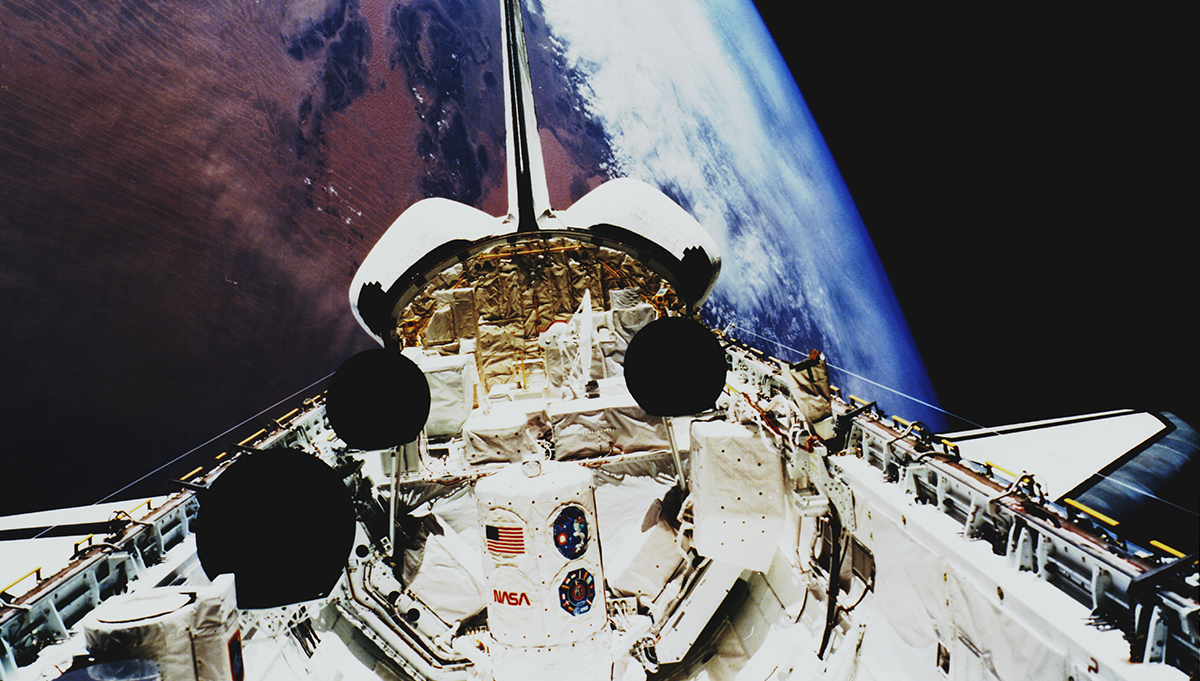
The crew members of the Apollo 13 mission step onto the deck of the U.S.S. Iwo Jima, following splashdown and recovery operations in the South Pacific Ocean. Aboard the ship, Fred W. Haise Jr., lunar module pilot (left); James A. Lovell, Jr., commander (center); and John L. Swigert, Jr., command module pilot, discussed writing an account of the perilous spaceflight.
Credit: NASA
Review board focuses on role of oxygen tank 2 in accident.
On April 17, 1970, the Apollo 13 Command Module (CM) streaked through Earth’s atmosphere, bound for the South Pacific Ocean and a rendezvous with the U.S.S. Iwo Jima. Inside the capsule, condensation rained down on Commander James A. Lovell Jr., Command Module Pilot John L. Swigert Jr., and Lunar Module Pilot Fred W. Haise Jr., the product of days when the CM was powered down to save energy.
Earlier, the dehydrated and exhausted astronauts had jettisoned Apollo 13’s Service Module and seen for the first time the extensive damage caused by an explosion four days earlier, more than 200,000 miles from Earth enroute to the Moon.
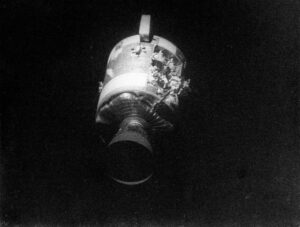
The damaged Service Module is captured in this image shortly before the crew returned to Earth.
Credit: NASA
“…When we jettisoned the service module and it floated on by, we saw this big, gaping hole, this panel blown out. That worried us that our heatshield was damaged because it was right next to our heatshield,” Lovell recalled in an oral history. “And there was nothing we could do about that. I mean, we were coming—we were aimed for the Earth. We’re going to come into the Earth. That was the end of the deal. If we’re going to burn up, we’re going to burn up.”
It wasn’t until the capsule bobbed above the water just four miles from the recovery ship and he saw that it wasn’t going to sink that Lovell acknowledged the crew was finally home free. Later, on the decks of the carrier, Swigert, Haise, and Lovell celebrated surviving Apollo 13, and vowed to someday write the story.
The millions of Americans who watched the splashdown that April would wait 24 years for Lovell’s account of the mission. At this point, NASA was interested in a different narrative—What exactly had gone wrong and why?
And so, on April 17, 1970, 53 years ago this month, NASA Administrator Thomas O. Paine appointed Edgar M. Cortright to chair a seven-member board to investigate the Apollo 13 accident. Cortright was then the Director of NASA’s Langley Research Center, having served as Deputy Associate Administrator for Space Science and Applications and Deputy Associate Administrator of the Office of Manned Space Flight.
The accident occurred about 55 hours and 55 minutes into the spaceflight, shortly after a procedure to stir the liquid oxygen in two tanks in the Service Module. It came at the end of a long day, and began with an electrical anomaly, a loud bang, and the report, “Okay, Houston, we’ve had a problem here.”
The investigation soon focused on oxygen tank 2, which had originally been installed in the Service Module assigned to Apollo 10. When it was removed in 1968 amid design changes, it was dropped a short distance, perhaps no more than two inches. The incident was noted, but externally the tank appeared unharmed.

Astronaut James A. Lovell Jr., commander, is hoisted aboard a helicopter from the USS Iwo Jima, prime recovery vessel for the mission. Lovell was the last of the three Apollo 13 crew members to egress the Command Module (CM) and the last to be lifted aboard the helicopter.
Credit: NASA
“In that tank, there’s a tube. It’s a fill tube, where you fill the oxygen, and it’s a tube from the outside meeting a tube from the inside, with a sleeve, a loose sleeve over it. And during that drop, we determined that that sleeve probably popped out, because if you took all the tolerances in the wrong direction, it was barely in to start with,” Cortright explained, in an oral history. “Well, when that was out, you could still fill it, but you couldn’t de-tank it by pressurizing it…”
This explained an issue during a Countdown Demonstration Test in March, when the team successfully filled Apollo 13’s two oxygen tanks but were only able to successfully drain tank 1. After two attempts to drain tank 2, it remained about two-thirds full.
“They tried to pressurize it, and the oxygen didn’t come out. …They didn’t know why for sure…,” Cortright said. “But they determined they could boil it off, just by putting some heat in. Liquid oxygen doesn’t take a whole lot of heat to make it boil, and it just bubbled the gases out. And they did that.”
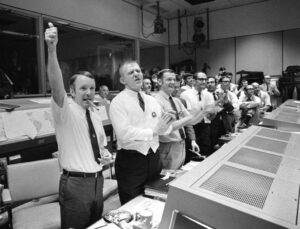
Flight Directors (left to right) Gerry Griffin, Gene Kranz, Glynn Lunney, and Milt Windler cheering after the successful splashdown of Apollo 13.
Credit: NASA
Investigators determined that this process had supplied a thermostatic switch within the tank with excess voltage. The switch failed to keep the heating element at temperatures below 80 degrees Fahrenheit. Because the temperature gauge didn’t extend much beyond 80 degrees, the technician overseeing the operation didn’t realize the heater had likely reached 1,000 degrees Fahrenheit, charring and gasifying the Teflon insulation, leaving bare wires exposed.
“And that happened at the Cape, and it was refilled. It could have conceivably blown at the Cape, but it didn’t, because those wires didn’t come in contact with each other,” Cortright explained. “…On the way [to the Moon] they used little fans in there, propellers, to stir the fluid to keep it uniform throughout. And they turned those on, and the fluid started to move, and apparently these two bare wires touched and ignited what Teflon was left on the wires, which anything will burn in liquid oxygen at those pressures. The Teflon burned and raised the pressure in the tank, and it blew it out. It didn’t blow out from a chemical explosion. It blew out from over pressure of oxygen gas.”
A team at what is now Johnson Space Center tested the switch and confirmed the board’s theory. Cortright released the final report of the Apollo 13 Review Board on June 15, 1970, at NASA Headquarters. The findings prompted a redesign of the Apollo oxygen tanks and the Service Module.
Following his retirement in 1991, Lovell recalled asking his longtime administrative assistant, “What should we do?” She replied, “Why don’t you write that book you’ve been telling me about for the last 14 years?” That book, Lost Moon: The Perilous Voyage of Apollo 13 was published in 1994. Optioned before it was published, it was the basis of the 1995 movie Apollo 13.
When asked about the enduring appeal of the Apollo 13 mission, Haise said, “It does make it very clear, you know, what can happen if you do have… the right people, the right skill mix, [who] are trained and they’re assembled in this team and they work together under the right leadership. You know, what a miracle can happen. And that’s what was the case of Apollo 13.”






